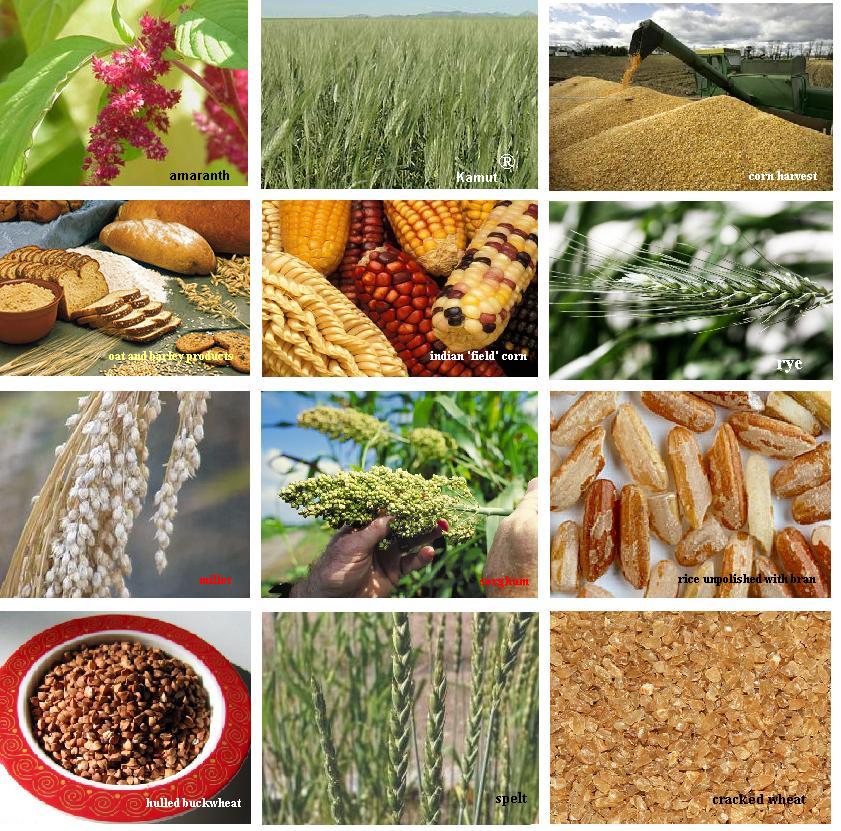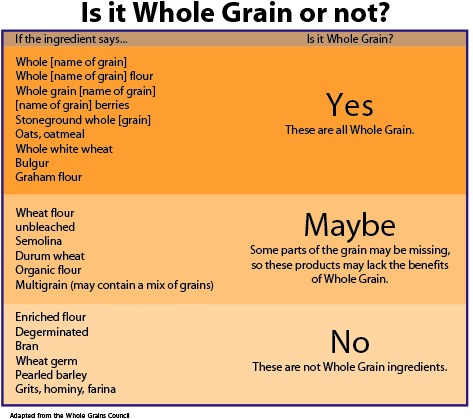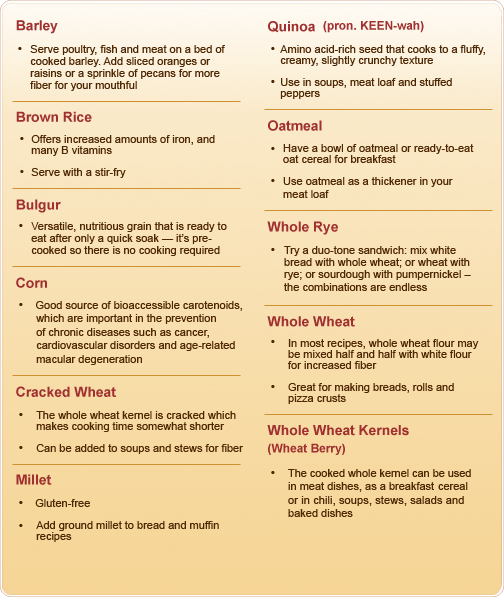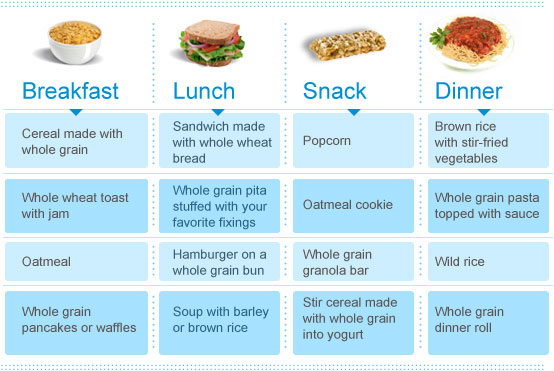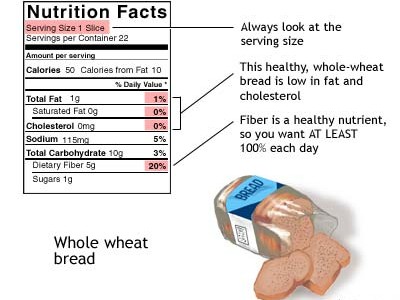Welcome to week five of the Six Weeks to a Healthy Diet course. This week’s lesson stresses the importance of getting more whole grains into your diet.
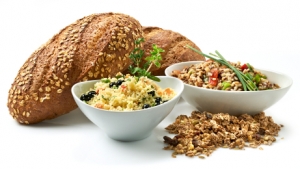 Week 5 – Going with Whole Grains
Week 5 – Going with Whole Grains
You’ve made it through four weeks, and if you’ve been keeping your food diary and following the lessons, you should be seeing some results when you look in the mirror or step on the scale. You’ve also made it through the most difficult lessons. This week’s lesson is easy: I’m going to teach you about whole grains.
The Goodness of Grains
Grains and cereals, such as wheat, oats, barley, rice, corn and spelt, have been a staple of the human diet for thousands of years. All of them are great sources of energy, vitamins and minerals. Of course, some are better than others; you’ll find grains and cereals in breads, pasta and breakfast cereals, but you’ll also find them in junk foods and snacks.
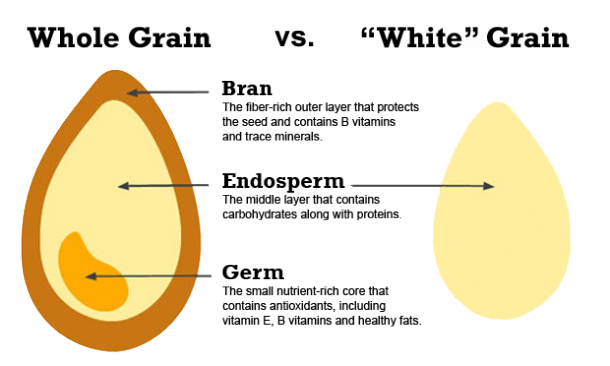 Why Whole Grains Are Better
Why Whole Grains Are Better
Whole grains include the entire seeds, which are rich in nutrients, fiber and phytochemicals that help to reduce your risk of several diseases. Refined grains have had parts of the seeds removed, so that rice dishes, breads and pasta turn out to be lighter and more delicately flavored than whole grain products. Unfortunately, the most nutritious parts of the seeds are removed, although white refined flour is enriched with some added B vitamins and iron.
The parts removed include the bran and the germ. The bran is the outer covering and contains lots of fiber, protein, niacin, vitamin B6 and several minerals. The germ is the part of the seed that germinates and becomes a plant. The germ is packed with lots of vitamins and minerals, such as magnesium, potassium and selenium. The part that remains after refining is called the “endosperm,” which makes up the bulk of the seed. This is mostly starch, which supplies the germinating plant with energy.
The biggest loss in refined grains is the fiber – important because so many people don’t get nearly enough fiber in their diets. A slice of white bread contains only about one-half a gram of fiber, quite a bit less than a slice of 100% whole grain bread that has at least two grams. Fiber is necessary for good health, because it keeps your digestive system functioning properly, but fiber does more than just help your digestive system: you can’t digest fiber, so it helps to slow down digestion and absorption, which keeps you feeling full longer.
One type of fiber, called “beta glucan,” absorbs cholesterol and removes it through the bowels. Oats are rich in beta glucans, so adding more oats to your diet will help reduce your cholesterol levels. Whole grains contain other phytochemicals too, such as lignans, flavonoids and polyphenols — all of which offer special health benefits.
According to the Institute of Medicine:
The recommended intake for total fiber for adults 50 years and younger is set at 38 grams for men and 25 grams for women, while for men and women older than 50, it is 30 and 21 grams per day, respectively, due to decreased food consumption.
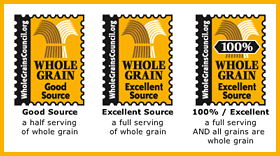 Which Grains Are Whole Grains?
Which Grains Are Whole Grains?
Look at the label when you buy breads, pasta and cereal. The labels should state, “100% whole-grain” or “100% whole-wheat.” Many products have labels stating they are made with whole grains or contain whole grain, but are not 100% whole grain. These products usually contain much more refined flour and usually don’t have any more fiber than regular white breads and pastas. It’s fine to eat them (they’ll help your taste buds make the transition from refined flours to whole grains), but they don’t count as a full serving of whole grain. For example, one serving of whole wheat pasta that’s made with 50% whole wheat flour counts as one serving from the bread and cereal group, but only one-half a serving of whole grain.
Most whole-wheat products will be brown, while refined products are pale or white. The coloring in whole-wheat flour comes from red-hued phenols (which are good for you). There is a type of wheat, called “white wheat,” that’s milder in flavor than regular wheat, so whole wheat white products offer the milder flavor of white flour with the goodness of whole grains.
These common grains are all considered whole grains when they still contain the bran, germ and endosperm:
Use this list to make sure that at least half of your daily servings of grains and cereals are whole grains.
If you’re strictly a ‘white bread and cereal’ person, it may take a little while for you to adjust to the different flavors and textures of whole grains.
Here are some ideas to get you started:
- Choose 100% whole grain breakfast cereals, or make oatmeal.
- Top whole grain pasta with spaghetti sauce.
- 100% whole grain breads are easy to find in any grocery store.
- Substitute whole grain flour in place of white flour in your recipes.
- Serve popcorn, but hold the butter.
- Switch from white rice to brown rice, which is much higher in fiber and minerals.
- Experiment with grains and cereals you may not have eaten before such as quinoa, spelt, or kamut.
All Grains and cereals are energy dense, including whole grains. The difference is that the fiber in whole grains will keep you feeling full longer.
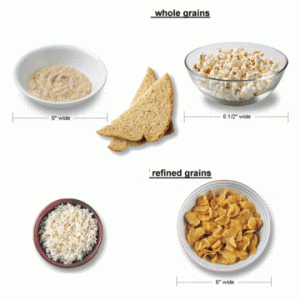 You need to keep an eye on portion sizes so you can estimate your calorie intake accurately.
You need to keep an eye on portion sizes so you can estimate your calorie intake accurately.
One serving is just one slice of bread, 3/4 cup of cereal or 1/2 cup pasta. That huge bagel in the coffee shop is the same as four or five slices of bread and a big plate of spaghetti might be even more.
This week I want you to focus on getting those whole grains into your diet every day.
Keep track of your whole grains in your food diary. At least half of your grains should be whole.
Choose a goal this week that works for you.
Here are two examples:
I will eat 100% whole grain sources instead of refined grain sources with three meals or more this week.
I will eat 100% whole grain cereal for breakfast three or more days this week.
Next lesson: Six Weeks to a Healthy Diet Week 6 Shaking the Salt
Going With Whole Grains Quiz
Think you got it all down? Take this quiz to make sure you are ready to move on to lesson 6.
1) You should never eat grains and cereals, because they are energy dense.
a. True
b. False
2) White bread has as much fiber as 100 percent whole grain bread.
a. True
b. False
3) Choose the best option.
a. Sugar frosted fruit-flavored breakfast cereal
b. Oatmeal with nuts and fresh berries
c. White bread toasted with grape jelly
d. French toast with extra syrup
4) Popcorn is a whole grain.
a. True
b. False
5) Women need more fiber than men.
a. True
b. False
6) The brownish color of whole wheat flour comes from a red polyphenol.
a. True
b. False
7) How many of your bread and cereal servings should be from whole grains?
a. 0
b. 1
c. 2
d. 3 or more
8) Which part of the grain remains in refined flour?
a. Endosperm
b. Bran
c. Germ
d. B and C
9) Why is fiber good for you?
a. Lowers cholesterol
b. Keeps your digestive system healthy
c. Keeps you feeling full
d. All of the above
Going For Whole Grains Quiz Answers
1) You should never eat grains and cereals, because they are energy dense. The correct answer is “b” False.
2) White bread has as much fiber as 100 percent whole grain bread. The correct answer is “b” False.
3) Choose the best option. The correct answer is “b”Oatmeal with nuts and fresh berries .
4) Popcorn is a whole grain. The correct answer is “a” True.
5) Women need more fiber than men. The correct answer is “b” False.
6) The brownish color of whole wheat flour comes from a red polyphenol. The correct answer is “a” True.
7) How many of your bread and cereal servings should be from whole grains?
The correct answer is “d” 3 or more.
8) Which part of the grain remains in refined flour? The correct answer is “a” Endosperm .
9) Why is fiber good for you? The correct answer is “d” All of the above.

